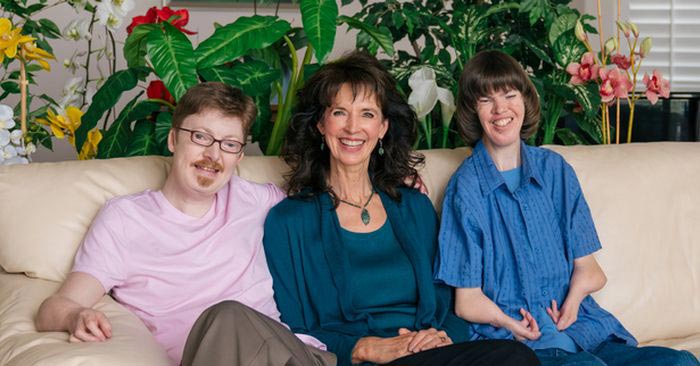
Behind the scenes, genetic scientists, biologists, researchers, and staff work in labs and offices gaining lessons which they learn from studying rare diseases. They sit at their computers and stand over tedious lab work. These scientists continue hoping and believing they will find answers, but often they don’t succeed. Instead of getting discouraged and quitting, they continue searching. They do this work to help people like our family find answers and be a story of hope for others.
One such laboratory, ARUP, highlighted our family’s story of hope and finding answers in their October 2018 monthly magazine, Magnify.
Finding Genetic Answers for Rare Diseases
When scientists discover long-awaited answers they’re excited! Sometimes, they find their answers in places they would never have thought to look. They tell the family involved, and the other scientists around the world. Their passion and successes renew hope to achieve the same success in other scientists. They continue learning from rare diseases, and searching for and finding answers to help people.

Our family’s answers came after 33 years of not knowing why my two children, Heather and Logan, were born with a rare disease, Miller syndrome, which affects only 30 people worldwide, and a rare lung disease.
My eyes filled with tears of happiness when scientists told me they found the genes responsible for causing my children’s lifelong challenges. This news was more than we dared hope for. We gained peace of mind from having answers and continue hoping that other family’s living with unknown diseases will also get answers.
Lessons Learned from Rare Diseases and Extraordinary Challenges
ARUP Laboratories is a national clinical and anatomic pathology reference laboratory. They are a worldwide leader in innovative laboratory research and development. They are a nonprofit enterprise of the University of Utah. ARUP offers an extensive test menu of highly complex and unique medical tests. They are located in Salt Lake City, Utah.
Peta Owens-Liston of ARUP Laboratories weaves together our family’s portrait that connects through time, giving perspective to a life defined by extraordinary challenges, successes, and synchronicities. Her article is in ARUP’s newsletter, Magnify. The story focuses on Logan Madsen, his art, and our family and how for over 32 years we had been hoping for answers. Genetic scientists found these answers.
Peta’s article highlights some of the scientific research through which scientists discovered the genetic causes for Heather and Logan’s two rare syndromes, Miller syndrome and Primary Ciliary Dyskinesia, PCD.
Why Search for Causes of Rare Genetic Disorders?
“Although there are many rare genetic disorders, collectively they may be present in approximately 3 percent of the world’s population,” says Chris Miller, one of ARUP’s 16 genetic counselors.
 “There are several benefits of determining the cause of a rare disorder. Parents who have children with the same disorder can be connected, even internationally, with one another and they support each other through life’s journey,” says Miller. Determining the cause of their child’s disorder enables parents to learn their chance of having another child with the same condition and allows researchers to begin developing targeted treatments for the condition.”
“There are several benefits of determining the cause of a rare disorder. Parents who have children with the same disorder can be connected, even internationally, with one another and they support each other through life’s journey,” says Miller. Determining the cause of their child’s disorder enables parents to learn their chance of having another child with the same condition and allows researchers to begin developing targeted treatments for the condition.”
The Foundation for Nagar and Miller Syndrome, FNMS, connected us with other families with Miller Syndrome.
Even when scientists don’t find the answer they’re looking for, they still benefit. They start with a hypothesis and if they discover their hypothesis isn’t correct this knowledge benefits their research. They look at different possibilities. Also, scientists often discover new research methods they can use for other important research during the procedure.
A Story of Hope, Answers, Lessons and Finding Beauty in Life
The title of Peta’s article is, A Singular DNA Destiny Decoding the Beauty and Hardships of Life. Along with the science, the article features Logan, his life as an artist, and his art.
The story leads with, “Buried in Logan’s DNA is also the capacity to develop arresting art (his family tree has been traced back to Vincent van Gogh), a lively intellect, and a deeply compassionate nature. Perhaps because tasks of daily life take longer and are more arduous for him, he observes the activity around him with a keen eye…”
 Logan sees the details in life and then paints them. He paints to live and at the same time lives to paint. This creates meaning and purpose in his life through his art. He communicates both the beauty and the hardships in life and changes many lives with his art. Making a positive difference in the world is a top priority for Logan.
Logan sees the details in life and then paints them. He paints to live and at the same time lives to paint. This creates meaning and purpose in his life through his art. He communicates both the beauty and the hardships in life and changes many lives with his art. Making a positive difference in the world is a top priority for Logan.
The article also includes some valuable lessons we’ve learned. We hope our insights can help other families as they go through their own challenges. For example, Peta quoted me saying, “I knew that if I couldn’t find happiness, how could they?” Peta included other insights we’ve gained that can help others.

